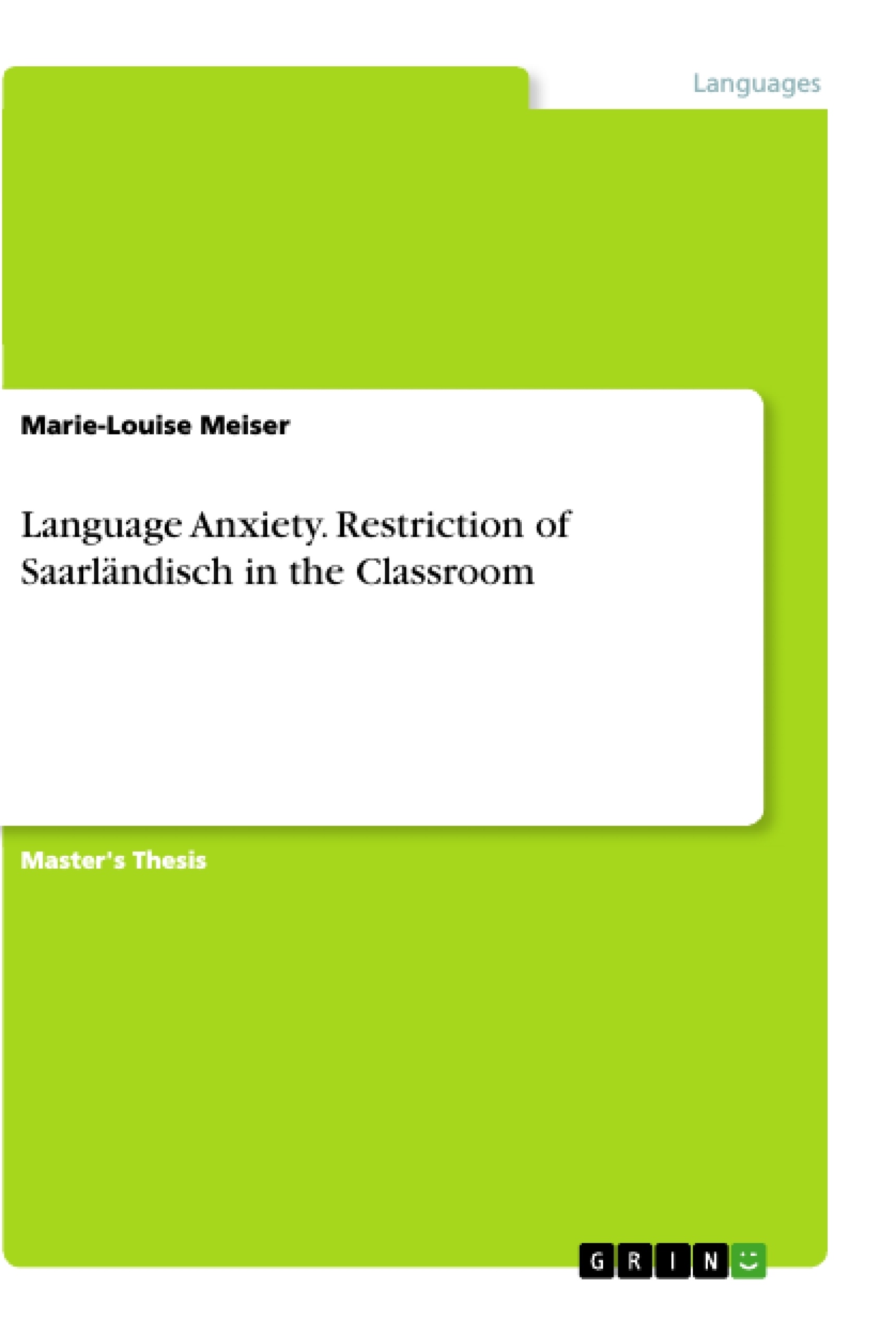This thesis explores how power relationships between language varieties are related to students experiencing language anxiety. It has specifically been looked into the relationship between the restriction of Saarländisch in the classroom and students experiencing language anxiety in the context of a primary school located in a rural area in the German federal state Saarland. In this area, the language variety Saarländisch is commonly not accepted within the classroom.
This thesis comprises an empirical study which has been analysed in a mix-method using both qualitative and quantitative data. The sample group consisted of 20 students in grade 4 who have been picked after answering a background questionnaire and who were then given the main questionnaire related to how Saarländisch is viewed in the classroom, the restriction of Saarländisch in school and language anxiety. Furthermore, the two teachers who teach the aforementioned students have been questioned in interviews.
It has been investigated that Saarländisch is seen as inferior to Standard German both in general and within the classroom. Even though, the restriction of Saarländisch in the classroom and students’ language anxiety have been found to not have a statistically significant correlation with each other, some qualitatively and quantitatively obtained data indicated a relation between the two variables. Therefore, the definition of language anxiety should be rethought and extended referring to learning and/or using different language varieties rather than only referring to the anxiety that appears when learning and/or using a second/foreign language.
Inhaltsverzeichnis (Table of Contents)
- Abstract: English
- Abstract: German
- Table of content
- Chapter 1. Introduction
- 1.1 Areas of research and aim of the thesis
- 1.2 Definitions and explanations of terms
- 1.2.1 Language, dialect and variety
- 1.2.3 Saarländisch
- 1.2.4 The "restriction of Saarländisch" in the classroom
- 1.2.5 Anxiety
- 1.2.5.1 Dimensions of anxiety
- 1.2.5.2 Language anxiety
- 1.3 Outline of the thesis
- Chapter 2. Review of the literature
- 2.1 An overview of the relationship between power and language
- 2.2 The power relationship between ‘high' language varieties and 'low' language varieties: diglossia
- 2.3 An overview of different perspectives of (language) anxiety
- 2.4 Anxiety in language learning
- 2.4.1 Communicative anxiety
- 2.4.2 Test anxiety
- 2.4.3 Fear of negative evaluation
- 2.5 Sources of language anxiety
- 2.5.1 Personal and interpersonal anxieties
- 2.5.2 Teachers' beliefs
- 2.5.3 Students' beliefs
- 2.5.4 Interaction between teachers and students
- 2.5.5 Classroom procedures
- 2.6 Factors associated with language anxiety
- 2.6.1 Sex and age
- 2.6.2 Motivation
- 2.6.3 Language proficiency
- 2.7 Effects of language anxiety
- 2.7.1 Facilitating anxiety
- 2.7.2 Debilitating anxiety
- 2.8 Rationale for the present work
- 2.9 Research questions and hypotheses
- Chapter 3. Methodology
- 3.1 Participants
- 3.2 Research instruments
- 3.3 Data collection method
- 3.4 Evaluation method
Zielsetzung und Themenschwerpunkte (Objectives and Key Themes)
This master's thesis investigates the connection between power dynamics in language varieties and language anxiety experienced by students. The study specifically focuses on the relationship between the restriction of Saarländisch in the classroom and language anxiety among primary school students in a rural area of the German federal state of Saarland. This region is characterized by the widespread use of Saarländisch, a language variety generally not accepted in the classroom.
- Power relationships between language varieties
- Language anxiety and its connection to the restriction of Saarländisch in the classroom
- The influence of teachers' and students' beliefs on language use and anxiety
- The perception of Saarländisch as inferior to Standard German
- The impact of language restrictions on students' language learning experiences
Zusammenfassung der Kapitel (Chapter Summaries)
Chapter 1 provides an introduction to the research area and the aim of the thesis. It defines key terms such as language, dialect, variety, Saarländisch, and anxiety, including the various dimensions of anxiety and the specific phenomenon of language anxiety. Chapter 2 reviews relevant literature on the relationship between power and language, focusing on the power dynamics between "high" and "low" language varieties, specifically in the context of diglossia. The chapter further explores different perspectives on language anxiety and its sources, examining factors associated with language anxiety, such as sex, age, motivation, and language proficiency. Finally, it discusses the effects of language anxiety and provides a rationale for the current work, outlining the research questions and hypotheses.
Chapter 3 describes the methodology of the empirical study conducted for this thesis. This chapter explains the selection of participants, the research instruments used, the data collection methods employed, and the evaluation method implemented.
Schlüsselwörter (Keywords)
This master's thesis revolves around the core concepts of language anxiety, language and power, language varieties, Saarländisch, and Standard German. The study investigates how power dynamics between language varieties, specifically the restriction of Saarländisch in the classroom, influences the experience of language anxiety among primary school students in Saarland.
- Quote paper
- Marie-Louise Meiser (Author), 2019, Language Anxiety. Restriction of Saarländisch in the Classroom, Munich, GRIN Verlag, https://www.grin.com/document/1021150



